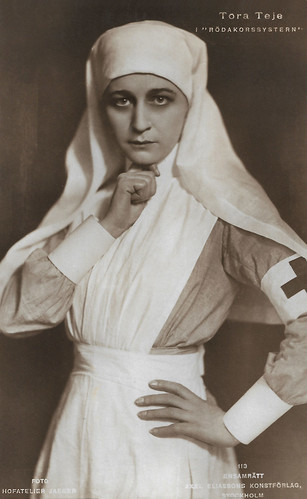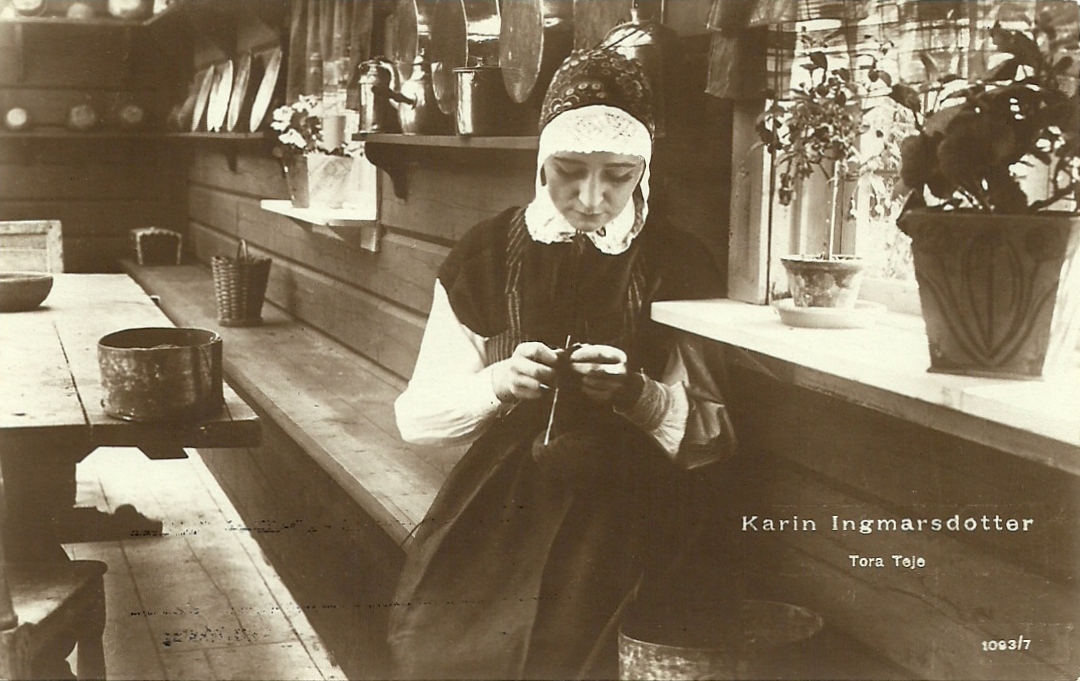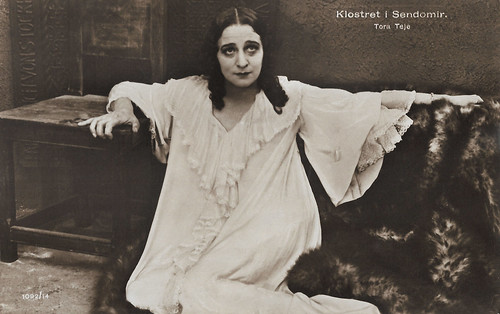
Swedish postcard by Axel Eliassons Konstförlag, Stockholm, no. 113. Photo: Hovatelier Jaeger. Tora Teje in the play 'Rödakorssystern' (Red Cross Sister) by Gustaf Collijn. The play premiered on 14 March 1919 at the Svenska Teatern. Director was Gunnar Klintberg and her co-star was Gösta Ekman.

Swedish postcard by Nordisk Konst, Stockholm, No. 1097/6. Tora Teje and Lars Hanson in Erotikon (Mauritz Stiller, 1920).

Swedish postcard by Axel Eliassons Konstförlag, Stockholm, no. 321. Photo: Hovatelier Jaeger, 1922.
Kleptomaniac
Tora Teje was the stage name of Tora Adelhejt Sylwander-Johansson. She was born in the St. Mary Magdalene parish in the Södermalm quarter of Stockholm, Sweden in 1893.
Tora studied at Dramatens elevskola, the Royal Dramatic Theatre School in Stockholm, from 1908 to 1911.
During her whole career - apart from the years 1913-1922, she was engaged at Dramaten, the Royal Dramatic Theatre, where she played many leading roles.
She played the title roles of Jean Racine's 'Phaedra' and Euripides' 'Medea', Indra's daughter in August Strindberg's 'Ett drömspel' (A Dream Play), Nina Leeds in Eugene O'Neill's 'Strange Interlude' and Christine Mannon in O’Neill’s 'Mourning Becomes Elektra'.
In the cinema, Tora Teje had her breakthrough with the romantic comedy Erotikon (1920) by Mauritz Stiller. It is based on the 1917 play 'A kék róka' by Ferenc Herczeg. The story deals with a professor (Anders de Wahl) who is obsessed with the sexual life of bugs but doesn’t notice his wife (Teje) is courted by two men. One of the two (Lars Hanson) is – unjustly - jealous of the other. The film became a commercial success and was sold to 45 markets abroad.
Two years later, Teje played a kleptomaniac, indicated as ‘Modern Hysteric’, in Benjamin Christensen's Häxan/Witchcraft Through the Ages (1922). Häxan is a study of how superstition and the misunderstanding of diseases and mental illness could lead to the hysteria of the witch-hunts. The film was made as a documentary but contains dramatized sequences that are comparable to horror films.
Hal Erickson at AllMovie: "Beginning in a deceptively sedate fashion with a series of woodcuts and engravings (a technique later adopted by RKO producer Val Lewton), the film then shifts into gear with a progression of dramatic vignettes, illustrating the awesome power of witchcraft in the Middle Ages. So powerful are some of these images that even some modern viewers will avert their eyes from the screen."
With Christensen's meticulous recreation of medieval scenes and the lengthy production period, the film was the most expensive Scandinavian silent film ever made, costing nearly two million Swedish kronor. Although it won acclaim in Denmark and Sweden, the film was banned in the United States and heavily censored in other countries for what were considered at that time graphic depictions of torture, nudity, and sexual perversion.

Swedish postcard by Nordisk Konst, Stockholm, no. 1093/2. Photo: Svenska Biografteatren AB. Tora Teje in Karin Ingmarsdotter/God/s Way/Karin Daughter of Ingmar (Victor Sjöström, 1920), starring. It is the second part in Sjöström's large-scale adaption of Selma Lagerlöf's novel 'Jerusalem', following Sons of Ingmar from the year before, and depicting chapters three and four from the novel.

Swedish postcard by Nordisk Konst, Stockholm, no. 1093/4. Photo: Svenska Biografteatren AB. Tora Teje and Tor Weiden in Karin Ingmarsdotter/God/s Way/Karin Daughter of Ingmar (Victor Sjöström, 1920).

Swedish postcard by Nordisk Konst, Stockholm, no. 1093/7. Photo: Tora Teje in Karin Ingmarsdotter (Victor Sjöström, 1920).
Oh God, we had fun!
Previously, Victor Sjöström had directed her in two films, Karin Ingmarsdotter/Karin, Daughter of Ingmar (1920) and the Gothic drama Klostret i Sendomir/The Monastery of Sendomir (1920).
Karin Ingmarsdotter/God's Way (1920) is the second part in Sjöström's large-scale adaption of Selma Lagerlöf's novel Jerusalem, following Ingmarssönerna/Sons of Ingmar (Victor Sjöström, 1919), and depicting chapter three and four from the novel. Teje played the title role as the daughter of Ingmar (Victor Sjöström). The critical reception of the film was unenthusiastic and Sjöström decided to not film any more parts. Eventually, the suite was finished by Gustaf Molander in 1926.
Klostret i Sendomir, based on a story by Franz Grillparzer, deals with a 17th-century monk (Tore Svennberg) who tells two visitors about a mighty count who discovers that his unfaithful wife has a longstanding affair with her own cousin and that even his daughter is not his own. He had to use all his resources to build the monastery where they are now staying. At the end of the film, it is revealed that the monk is in fact the count himself.
Teje also acted in Familjens traditioner/Family Traditions (Rune Carlsten, 1920) with Gösta Ekman and Mary Johnson.
She had the lead in Norrtullsligan/The Nurtull Gang (Per Lindberg, 1923) about low-paid female clerks who go on strike, and acted in 33.333 (Gustav Molander, 1924) with Einar Hanson as the winner of a lottery ticket.
Her last silent performances were as Marguerite Gauthier in Damen med kameliorna/The Lady with the Camelias (Olof Molander, 1925), based on Alexandre Dumas fils’ famous play and with Uno Henning as Armand Duval, and as Signe Rosenkrans in the August Strindberg adaptation Giftas/Getting Married (Olof Molander, 1926), again with Henning.
After years on stage Teje returned one time to the screen in 1939, acting opposite Victor Sjöström in Gubben kommer/The Old Man is Coming, based on Gösta Gustaf-Janson’s 'Gud, vad vi haft roligt!' (Oh God, we had fun!), tells about himself and about his mother.
Tora Teje died in 1970 in Stockholm. She was 77.

Swedish postcard by Förlag Nordisk Konst, Stockholm, no. 1092/6. Photo: Tora Teje and Richard Lund in Klostret i Sendomir/The Monastery of Sendomir (Victor Sjöström, 1920).

Swedish postcard by Förlag Nordisk Konst, Stockholm, no. 1092/8. Photo: Tore Svennberg and Tora Teje in Klostret i Sendomir/The Monastery of Sendomir (Victor Sjöström, 1920).

Swedish postcard by Förlag Nordisk Konst, Stockholm, no. 1092/14. Photo: Tora Teje in Klostret i Sendomir/The Monastery of Sendomir (Victor Sjöström, 1920).
Sources: Hal Erickson (AllMovie), Wikipedia (Swedish and English), and IMDb.
This post was last updated on 24 August 2021.
No comments:
Post a Comment